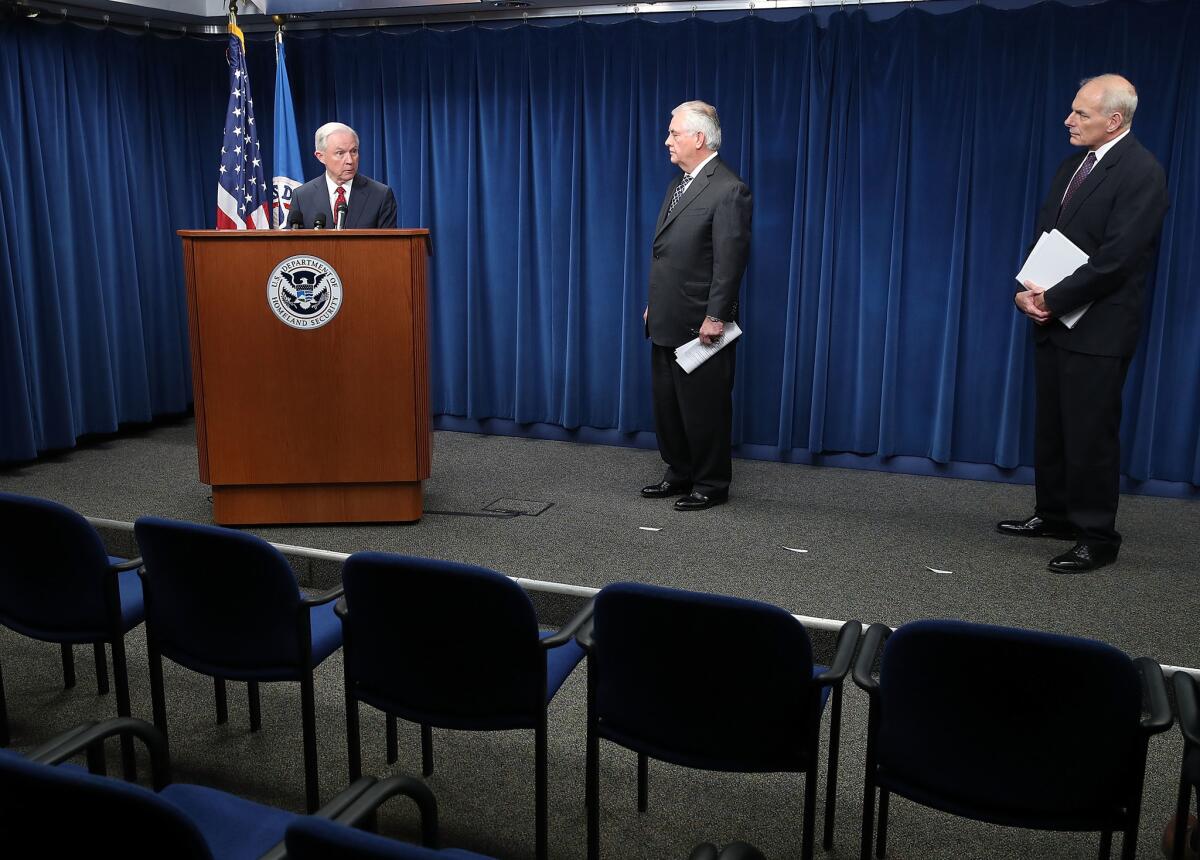Trump cedes the spotlight on travel order as White House tries a more familiar tack

Reporting from Washington — A staple of President Trump’s early flurry of executive actions was the big reveal – the president seated behind a desk proudly displaying his new edict for the cameras.
On Monday, though, when Trump signed a second order temporarily halting travel from nations deemed to pose a high risk to U.S. security, there was no show of the president affixing his jagged penmanship to an official document. Instead, three Cabinet secretaries spoke publicly blocks from the White House.
Gone was the immediate implementation that triggered chaos the first time, replaced with a 10-day preparation period.
Both the public unveiling of the new directive and private machinations leading up to it revealed how the Trump administration was course-correcting after stumbles in its tumultuous early weeks. And sidetracked again this weekend by Trump’s unsubstantiated claims that President Obama illegally ordered surveillance of his communications during the campaign, the administration found value in demonstrating it could function relatively routinely.
“That’s what we wanted to highlight today, is the government getting it done,” White House Press Secretary Sean Spicer told reporters Monday.
Notably, that meant that reporters had no scheduled opportunity to see the president at work, for the first time in the 32 weekdays of the Trump administration.
It was on his sixth working day, Jan. 27, that Trump traveled to the Pentagon to sign the initial executive order banning travel to the U.S. from seven mostly Muslim nations, while also indefinitely banning the admission of Syrian refugees and halting other refugee admissions for 120 days.
At first, the only glimpse the public had of the order was on one-and-a-half pages that the president proudly displayed from behind a wooden desk bearing the seal of the president, his new Defense secretary and Vice President Mike Pence behind him.
The White House neither published the executive order nor answered questions about it for hours, and the confusion blossomed in the following days amid long waits at airport immigration lines, detentions and protests.
Monday’s rollout was more deliberate, with White House aides and agency officials briefing reporters, followed by an on-camera announcement by Atty. Gen. Jeff Sessions, Secretary of State Rex Tillerson and Homeland Security Secretary John F. Kelly.
The only confirmation of Trump’s role in the order was a photo tweeted by Spicer showing him signing it.
“We did a phenomenal job of rolling it out and making sure the American people saw the faces of the departments that were instrumental in implementing it,” Spicer said.
The White House offered two main explanations for the dramatically different approaches. First, when the initial order was released, neither Sessions nor Tillerson was in office yet as they awaited confirmation. And second, court decisions suspending the first order gave the administration a road map to avoid further legal challenges.
When the U.S. 9th Circuit Court of Appeals upheld a lower-court decision suspending implementation of the initial order on Feb. 9, Trump had famously tweeted, “See you in court.” But by Saturday night, when he was surrounded at his Mar-a-Lago estate by Sessions, Kelly and other top legal and policy advisors to review the language of the revised order, he also signed off on their recommendation to no longer press ahead with the legal fight over the first.
“There was an element of surprise that benefited our country’s safety. We lost that after the 9th Circuit ruled the way that it did,” Spicer said of the initial order. “I think that our goal was to make sure that we used that time to ensure the most effective implementation, which I think you’re seeing by all accounts today.”
The initial order was largely drafted by Stephen Miller, the president’s top policy advisor, and Stephen K. Bannon, his chief strategist. Spicer said Monday that the revised order was crafted after a more extensive review process involving the White House’s Domestic Policy Council but led by the Homeland Security Department.
Justice Department lawyers, including those from the Office of Legal Counsel, played an “active” role in writing, revising and approving the final draft of the order, according to two officials at the agency. The State Department worked with the Iraqi government to gain assurances that led to its removal from the banned nations list.
And White House officials also sought more significant input from lawmakers than they had before the first order, a key factor that left the administration nearly isolated in defending it at the time.
“You always look back and do an after-action report, figure out what you could have done better,” Spicer said.
“The president’s new immigration executive order addresses some of the concerns I had with the original ban,” said Sen. Susan Collins of Maine, a centrist Republican. She had previously been critical of what she described as the insufficient vetting of the plan, and described an exemption in the initial order for Christians as likely to be unconstitutional.
Democrats, though, described the changes as purely symbolic.
“No amount of relabeling will change the fact that President Trump’s travel ban is unconstitutional and un-American,” said Sen. Richard J. Durbin of Illinois, the Democratic whip. “Trump’s first travel ban was blocked by multiple federal courts, and his latest will no doubt face the same fate.”
Spicer’s primary daily news briefing was itself held in the White House press room but on the condition that cameras not broadcast the proceedings, as he faced questions not just about the new order but the basis of Trump’s claim that former President Obama had ordered direct surveillance of him during the 2016 campaign.
Spicer adhered to the long-running White House posture when it comes to the president’s social media musings, saying the “tweet speaks for itself.”
Times staff writer Del Quentin Wilber contributed to this report.
Twitter: @mikememoli
ALSO:
Trump orders new, narrower travel ban that goes into effect in 10 days
The Trump administration faces multiple threats as it seeks to investigate itself
Citing no evidence, Trump accuses Obama of tapping his phones during the election
More to Read
Sign up for Essential California
The most important California stories and recommendations in your inbox every morning.
You may occasionally receive promotional content from the Los Angeles Times.










